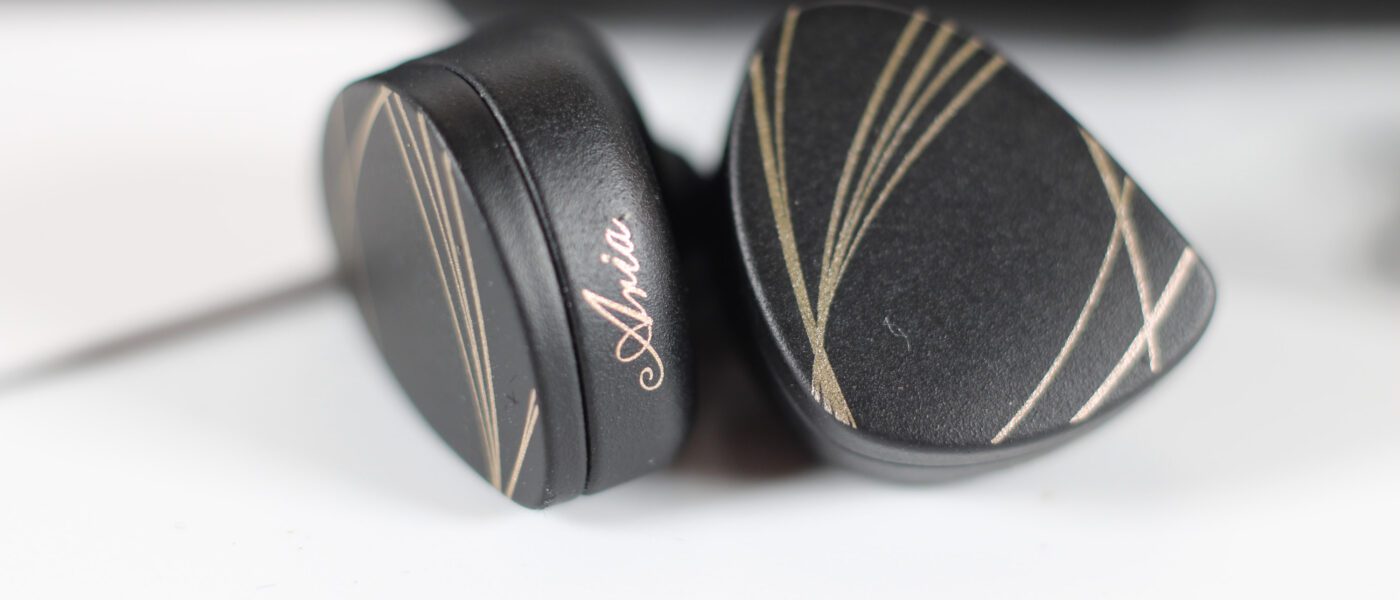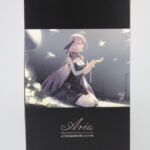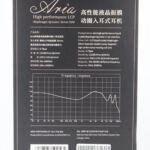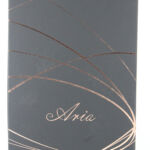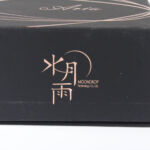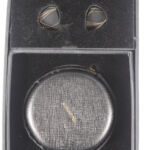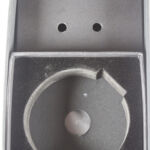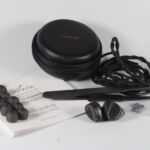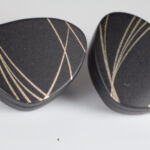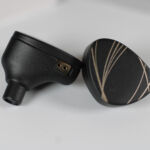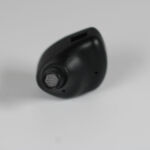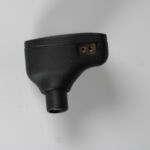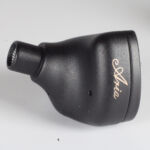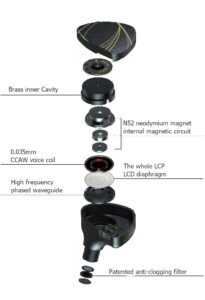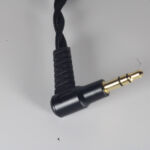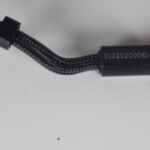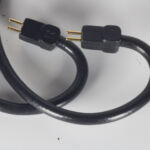Moondrop Aria
disclaimer: I received the Moondrop Aria from Hifigo in exchange for this review. If you have an interest in the Aria, you can follow Moondrop on facebook, or shop Hifigo. Those who have followed me for any length of time here will know I have owned and the Kanas, Kanas pro (KP), KXXS, and starfield among others. I have no affiliation with Moondrop or Hifigo other than customer and have no financial interest in either outfit. I will readily concede that I have enjoyed Moondrop’s previous models, and do have a bit of expectation bias as a result.
Unboxing / Packaging:
The Aria comes in a tall, narrow lift top box with a slip-cover with the return of Moondrop’s signature anime drawing on the cover and specs and FR plot on the reverse. The box itself is a book fold in black with gold accents and looks higher end than the price being asked. Internals share the black and gold theme as do the earpieces and case. Internally, the space is split horizontally with the earpieces in a surround at top, and the case at bottom hidden behind another gold and black panel. The kit includes 6 sets of tips, the cable, warranty cards, case, replacement grill/filters, and a set of tweezers to help install them. At the price point it is a fairly complete offering although I do wish the case were a bit larger as it is pretty tight.
Build/Fit:
Moondrop didn’t release many details about the shell materials of the Starfield, but has chosen to go the opposite route here. Shells are listed as alloy with a brass inner cavity with high frequency waveguides and a CNC machined outer shell. The Aria size and shape look much like previous models but corners are less rounded and finish is more industrial and is listed as matte metal spray which appears to be powder coating with gold accents added. Shells are the standard two part design with an outer face-plate and the inner body that includes the nozzle. Nozzles exit the lower/front edge of the shell with a slight forward rake and lack a lip for tip retention. The inner shells have two vents, one immediately below the nozzle and a second in line with the bi-pin connector on the inner face of the shell. Seams are quite visible but well fitted with little or no variation in width, and no glue or gaps. Size is best defined as small to medium with average depth so fit shouldn’t be an issue for all but the smallest ear. Tips insert fairly deeply when seated properly giving the Aria reasonably good isolation. Weight is about average and no physical fatigue was noticed during long sessions.
Internals:
Moondrop’s line has long been dominated by 10mm dynamic drivers and the Aria follows suit, this time with a liquid crystal diaphragm. Magnetic structure is listed as N52 Neodymium with a CCAW voice coil. The drivers used by Moondrop are all clearly related but do show evolutionary change as the starfield used a carbon nanotube diaphragm while the Aria uses the LCP version. The driver does share a lot with previous models as size, signature, and impedance are all very similar to the starfield. Nominal impedance is listed as 32Ω with a sensitivity of 122 dB/mW @ 1kHz. which are exactly the specs listed for the Starfield. The Aria is easy to drive with a phone or tablet but does scale some both qualitatively with better sources. I could be very happy with the Aria paired with a small dap or dongle as it simply does not need loads of power to do good work.
Cable:
To me, the cable is the one place the Aria takes a step backward and its an odd dichotomy. The cable is extremely well made, cloth wrapped, and heavier than the version provided with the Starfield while retaining the moulded 90º 3.5mm jack but does away with the coin splitter in favor of a flattened barrel design with a chin slider. All this sounds great but the cable is entirely too tangle prone and kinks up the second it is put in the case and I spend the first few minutes after getting the Aria out of the case un-kinking it. The cable itself is silver plated oxygen free copper The wires exit the splitter as single cloth wrapped wires up to the preformed hooks with .78mm bi-pin connectors. The hooks do not have memory wires and are fairly loose which I like, but the connector markings are hard to see so L/R takes a moment to index. As with previous models, the bi-pin connector fits into a recess in the shell and has potential to limit the use of after-market cables as the size and style of the bi-pin housing will have to remain nearly the same as the provided cable in order to fit properly.
Sound:
Bass:
Sub-bass extension matches previous models with roll-off only evident in the 20Hz range. Sub-bass is boosted through most of its range with a peak that centers between 40 and 60Hz, and a subtle drop above that through the rest of the range. The Aria good rumble when called upon, but is tight enough that the sub-bass does not distract when not called for. Mid-bass is punchy and tight enough to not feel thickened but still lends some warmth to the overall sound. The mid-bass does have a small amount of bleed, but not enough to mask the lower mids. The driver is slightly faster on attack than decay as well which also contributes some to the warmth of the mid-bass. Textures in the bass are good, and very similar to the KXXs and slightly better than starfield in my experience.
Mids:
Lower-Mids have good clarity with a little added warmth and male vocals have good weight without sounding heavy or dull. Guitar growl is good if slightly on the thick side due to the added warmth. True mids are quite good with violins having a near realistic tonality and enough energy to really project. There is a very gentle rise to the upper-mids that gives Female vocals enough lift to be slightly forward but again have good weight and tonality and cut through the instrument mix without feeling artificial. Even at the highest point, the upper-mids sit slightly behind the bass peak so the Aria presents a warm overall sound. Mids are on par with previous models like the KXXs and are better voiced than their immediate predecessor the Starfield with a bit more presence and a bit better tonality.
Treble:
The lower treble shares the climb of the upper-mids before plateauing out and then dropping off above the 5kHz mark fairly substantially. This is the biggest difference in the Starfield and Aria to my ear with the starfield having more energy in the 5kHz to roughly 9kHz range and the Aria being a bit recessed in this area and a bit more polite. The treble sensitive will likely prefer the Aria while those who find the Aria slightly lacking in treble energy have the Starfield to fall back on. There is a minor peak at about the 13kHz range that adds back a little sparkle and air and keeps the Aria from feeling closed in. Extension is roughly the same as previous models with it only becoming apparent at abotu the limit of my hearing (14kHz). Snare rattle is slightly blunted but still good and cymbals have no metallic click but hi-hat does lack the energy it needs to sound 100%.
Soundstage / Imaging:
Soundstage is quite good with slightly more width than depth and a reasonable amount of height. Seating the orchestra is straight forward with everything in the proper place and instrument separation is good was well. Layering is good but does show some of the limitations of a single dynamic and some compression does become evident on particularly busy tracks. Imaging is good, but nothing particularly out of the ordinary and very similar to previous models in this line.
Comparisons:
Moondrop Starfield
These two are definitely fraternal twins in nature. Shells are more similar than not with the Starfield being more polished and the Aria feeling slightly more industrial. The Starfield uses a Carbon Nanotube driver vs the LCP here but both share nearly all the particulars of the driver, and shells are more similar than not. The Starfield is slightly more treble forward while the Aria has slightly better mids. This one will come down to preference.
Moondrop KXXs
Going back another generation, the KXXs also shares a lot. Corners are more rounded and polish is much higher on the shell, but shape and size remain the same. The KXXs is a finger print magnet while the Aria’s dull finish doesn’t even reflect light. Internally the KXXS uses a diamond like carbon coated driver while vs the liquid crystal used in the Aria, but both are 10mm single dynamics with very similar impedence and sensitivity although the Aria is a bit easier to drive. The KXXs has a bit better details when compared to the Aria, but I prefer the mids of the Aria slightly as the KXXs has a bit less lower mid emphasis to my ear.
Thoughts / Conclusion:
The Aria is basically a slightly modified cheaper Starfield or KXXs. Seeing as both of them were on my recommended list, it would be hard for the Aria not to end up there too and indeed it does. The Aria offers a slightly different tuning with more mids and a bit less treble than either the Starfield or KXXs and will immediately please the treble shy and those who wanted a bit better mids than the Starfield provided. Each new iteration proves that Moondrop is continuing to learn and improve their craft and the fact that prices are falling as this happens is a side benefit that makes it easier for a broader range of people to purchase and enjoy Moondrop products. I have to applaud Moondrop for continuing to improve their budget line rather than focusing on just the high end models like a lot of their contemporaries have been doing. It’s great to have a product I can recommend whole-heartedly to the curious without having to spend the next hour trying to explain why that price isn’t ridiculous. The Aria is an easy recommendation, if you don’t already own a Starfield or KXXs, you should go get an Aria. If you do already own those two, you may still want the Aria for its improved mids.
-
Bass - 7.5/107.5/10
-
Mids - 8/108/10
-
Treble - 7/107/10
-
Soundstage - 8/108/10
-
Imaging - 7.5/107.5/10
Summary
Pros: Nice industrial look, super build quality, better mids than Starfield, slightly more polite treble.
Cons: Cable, slight lack of energy in treble, very similar to other Moondrop models (lots of overlap with Kxxs/Starfield)

